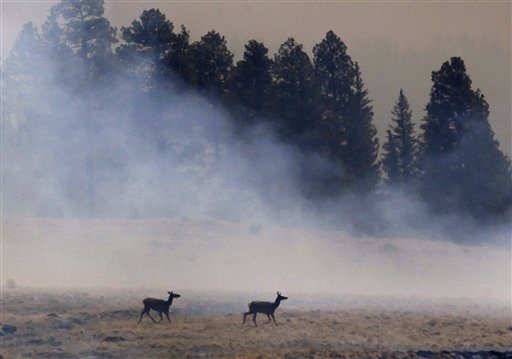EAGAR, Ariz. (AP) — Firefighter Jay Walter knows the sounds of danger in the pitch black of night — the crackling of burning embers, the whoosh of flames whipped by wind, the hair-raising thump of a burned tree hammering down on the forest floor.
The 32-year-old from the Phoenix area is a division crew supervisor overseeing hundreds of firefighters working the night shift on a huge eastern Arizona wildfire that’s been burning since May. Vigilance on the blaze is around the clock.
It’s dangerous during the day, but at night, things get even more dicey for crews protecting towns, putting out hot spots and beating back the blaze to keep it from advancing.
“It’s really dark out there,” Walter said. “You don’t have the ability to see all the land and property around you.”
Large trees weakened by fire pepper the forest floor. It only takes one gust to bring them down, sometimes too close for comfort.
“You could be standing out there one minute and all of a sudden you have a tree come down and it can kill us,” Walter said, adding that the only warning moments before it falls is the cracking of the trunk. “You want to talk about a sound that will send shivers up your spine.”
Scouts fan out into the dark woods ahead of the main crews to spot the fire and report back hot spots to attack. But they don’t venture far off the roads because it’s too easy to get lost in the dark. They have to stay together.
“We can’t see the terrain,” Walter said. “You just have to know where you are at all times
“And when the fire’s making a run, its putting out good heat and you have to watch the embers,” he added, noting that each time one falls behind their line, it must be immediately extinguished or it could light a blaze that traps them.
As the day and night battle to control the blaze continued, firefighters on Sunday expressed the first real sense of hope that they were making progress. Officials allowed roughly 7,000 residents to return to two mountain towns that had been threatened for days by the blaze.
“We’ve been praying every day to come home,” Springerville resident Valarina Walker, 49, said Sunday while chatting with other returning locals outside a convenience store in town.
The bed of her red pickup truck was overflowing with boxes of photo albums and family heirlooms.
“Just took what couldn’t be replaced, left the rest behind,” Walker said crying. “I’m just so happy and excited to be home. We thank God for those firefighters.”
Authorities still cautioned the elderly and those with health problems or very young children to stay away because of lingering smoke causing hazardous air quality, but they said the threat from the fire to the communities was past. Air quality warnings were also issued as far away as Albuquerque and Santa Fe.
About 2,700 other people who live in several Arizona resort communities in the Apache-Sitgreaves National Forest remained under an evacuation order.
“It’s so good to be home and see all the people we missed,” said Jane Finch, 51, who had just returned to nearby Eagar and had a tearful reunion with her husband, who stayed behind to keep the Circle K open for firefighters.
Meanwhile, firefighters stopped short of jubilation Sunday but said they were finally gaining ground against the entire 693-square-mile inferno that was running along the New Mexico state line.
“Everything is holding,” Fire Operations Chief Jerome Macdonald said. “Compared to what we’ve been dealing with just two days ago … we’re feeling a lot more confident. We turned a corner.”
Macdonald said strong winds have actually helped firefighters as the gusts burned off fuel in the central part of the blaze before it reached their fire lines. Fire containment was at 10 percent by Sunday night.
Just across the border in New Mexico, hundreds of firefighters worked to keep the flames at bay, burning off fuel that could feed the inferno.
Thirty-five homes and cabins have been destroyed since the fire began May 29.
While the blaze remained perilously close — about four miles away — to two major power lines that bring electricity from Arizona to West Texas, Macdonald said firefighters were able to burn off most of the fuel in between, lessening the risk of disruption. The fire still threatened the picturesque Arizona mountain towns of Alpine, Nutrioso and Greer, where officials said residents would likely not be allowed back in for up to five more days.
The small New Mexico town of Luna, just across the state line, also remained under threat. About 150 New Mexico National Guard soldiers were assisting crews with evacuations and security.
Officials said about 4,300 people were working to bring the fire under control, and the blaze had so far cost about $27 million to fight.
It is the second-largest in state history, and Macdonald said he didn’t it expect it would surpass the state’s largest — the 2002 Rodeo-Chediski fire that burned 732 square miles (1,895 sq. kilometers) and destroyed 491 buildings.



